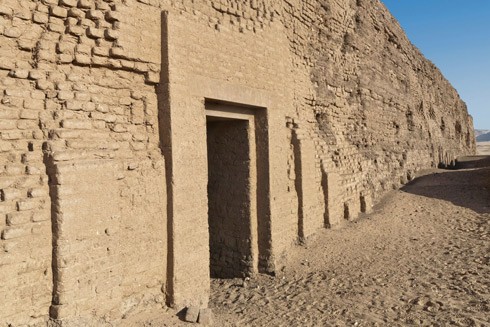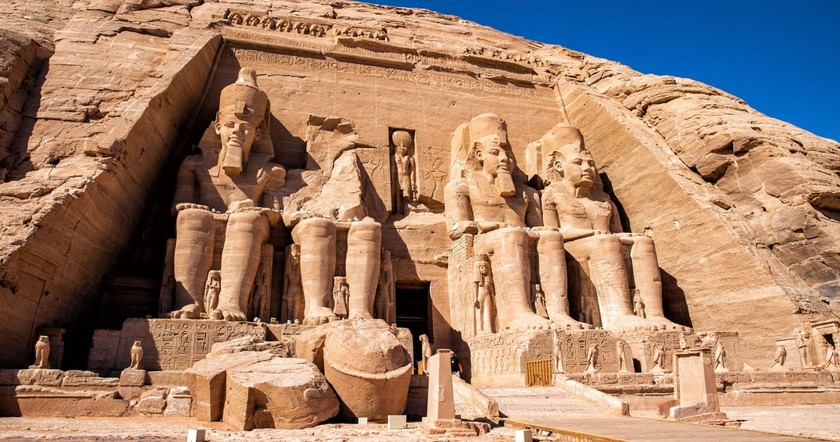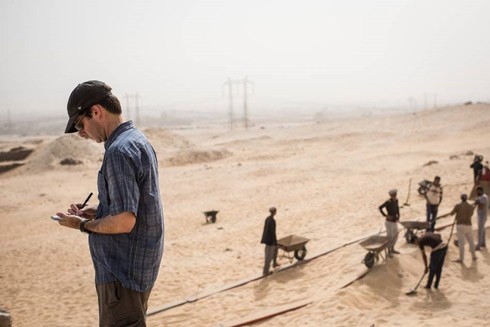
After the “January 25 Revolution” in 2011 led to the collapse of the Egyptian Government under the leadership of President Hosni Mubarak after 30 years of existence, the country faced huge security gaps. And due to lack of protection, the country’s cultural heritage and archaeological sites have been seriously damaged and gradually destroyed. ICOM has published a red list of Egyptian antiquities at risk of “disappearing” to raise public awareness in preserving the heritage of the disappearing Nile civilization.
I. Controversy surrounding Egyptian Heritage:

In 2011, ICOM published a red list of Egyptian antiquities at risk of “disappearing” to raise public awareness in preserving the heritage of the disappearing Nile civilization. The sale of a 4,500-year-old limestone statue of Sekhemka – the Pharaoh’s bronze keeper – made from limestone by the City Council of Northampton, England for 15 million pounds (more than 25 million USD) at an auction in London by Christie’s. ‘s organization has raised many disagreements about the value and protection of Egyptian heritage. This work was originally acquired by the second Marquess of Northampton during his trip to Egypt in 1849-1850. Then the 3rd or 4th Marquis returned the statue to the city museum in 1880 with the purpose of displaying and spreading the value of Egyptian art to the public. According to the plan, the marquis’s family will receive 45% of the money from the sale of the statue, and the remaining 55% will belong to the City Council to develop the museum and organize cultural exhibitions. David Mackintosh, Councilor, Conservative leader of Northampton City Council said “This money will help us deliver many plans for the development of the Museum and many of our arts and cultural projects. city.” The purchase and sale of this statue has faced much opposition from the governments and people of both Egypt and England. Previously, Egyptian Minister of Antiquities El-Mamdouh Damati, requested the Egyptian Embassy in London to prosecute the sale of the Sekhemka statue by the Northampton Museum. Mr. Ahsraf Elkholy, Egyptian Ambassador to the UK – criticized “Northampton should return the statue to its rightful place. This auction is “an insult to cultural and archaeological heritage.” Egypt”. A spokesman for the British Ministry of Culture said “Northampton Museum is owned and operated by the City Council. They have the right to decide whether or not to sell the museum’s antiquities. However, the Council The British Art Council may revoke the Museum’s status.” Arts Council England has warned that when the auction of the statue takes place, the museum will lose its recognized status and will therefore be ineligible to receive future grants and fundraising. hybrid.
Meanwhile, many locals have made arguments to defend the statue. “The museum is not a shop. The Sekhemka statue belongs to Egypt and if Northampton City Council no longer needs it then then then it must be returned to Egypt. It is not a normal item to be easily accepted for sale. Northampton City Council should speak to the Egyptian government about this issue.” Sue Edwards, one of the members of the Save Sekhemka Action Group, emphasized that “this is the darkest cultural day in the history of the city of Northampton”. Alan Moore, famous author of the classic graphic novels “V for Vendetta” and “The League of Extraordinary Gentlemen” shared with the BBC “Commitment to preservation is one of the basic principles for museums have access to their sources of antiquities. I have donated many antiques to museums but I will not do that anymore knowing that my spiritual gifts will be sold.”


The Egyptian Antiquities Committee of the International Council of Museums (ICOM CIPEG) also expressed concern over the sale of the statue. The Sekhemka auction could increase illegal excavation and trading of Egyptian antiquities. Since then, many famous masterpieces of ancient Egypt will have been lost to the public as part of private collections. ICOM CIPEG has called on Northampton City Council to abandon the sale of Sekhemka’s statue to demonstrate the humanity of public institutions tasked with protecting important world heritage sites.
After the “January 25 Revolution” in 2011 led to the collapse of the Egyptian Government under the leadership of President Hosni Mubarak after 30 years of existence, the country faced huge security gaps. And due to lack of protection, the country’s cultural heritage and archaeological sites have been seriously damaged and gradually destroyed. ICOM has published a red list of Egyptian antiquities at risk of “disappearing” to raise public awareness in preserving the heritage of the disappearing Nile civilization.
II. Urgent issue: Threats from terrorism, looting and smuggling:

The looting that took place at the Malawi museum in August 2013 raised alarm bells about the security state of regional museums across Egypt. More than 1,000 artifacts were stolen or looted, including a 3,500-year-old limestone statue, ancient jewelry, an 18th-century statue of Pharaoh Akhenaten’s daughter and many Greco-Roman coins. In January this year, a bomb attack in Cairo destroyed the facade and much of the interior of a museum of Islamic art, highlighting the serious threat to heritage and cultural sites in the capital. capital of Egypt. While concern about the destruction of Egyptian sites is increasing, illegal excavation at sites has been going on for centuries and has tended to increase from 2011 to the present. Many ancient tombs are illegally dug up in the hope of finding valuable artifacts and selling them abroad. In an interview with Al-Ahram Weekly, Salima Ikram, professor of Egyptology at the American University in Cairo, said “Archaeological sites are no longer protected since 2011 when government troops withdrew. Up to now, illegal antiquities trade has been taking place more and more complicatedly. The number of armed criminal gangs operating under the direction and guidance of many specialized organizations is increasing, targeting Egyptian sites. Robbery also often occurs in desert areas, where patrol activities are difficult. The robbers are always fully equipped with automatic weapons while the security team’s armament is limited. The violation and destruction of these sites is a huge loss for Egypt. This country’s history is gradually being lost.” According to the Alliance of Antiquities, an organization of archaeologists based in the US, “the theft of antiquities at major sites in Egypt continuously increased after the January revolution, when a large number of Egyptian cultural heritage and antiquities regularly appear in auctions in Europe and North America. “Tens of millions of dollars in stolen antiquities were taken out of Egypt. Profits from the illegal trade in antiquities and cultural heritage have caused the looting of museums, shops, religious establishments and archaeological sites to become increasingly rampant. The thieves left with priceless and irreplaceable treasures.” The severity of the problem is assessed by examining cameras at archaeological sites and monitoring the number of Egyptian antiquities sold abroad. According to Monica Anna, an Egyptian archaeologist and co-founder of the Facebook site Forces to Save Egyptian Heritage, the “tragedy of the Abu Sir Al-Malaq archaeological site south of Cairo has become a growing problem.” common disaster for the entire heritage of this country.” Anna said that 80-85% of Egyptian sites were looted. Thieves have turned the ancient mausoleums into a mess, with holes and tunnels dug around and scattered bones and mummies. Documents and photos of the looting and destruction of Egyptian heritage were published on the website of the Force to Save Egyptian Heritage. In addition to images of “the destruction at Abu Sir Al-Malaq”, the website also archives evidence of similar situations occurring at the site of Al-Hiba south of Fayoum, in the Dakhla oases and Bahariya in the Western Desert and the Upper Egyptian sites of Sohag and Aswan.


Furthermore, architectural and decorative details in Islamic buildings, including mosques and Coptic symbols of the Egyptian church, are also becoming targets for theft. According to unverified reports on the website of the Forces to Save Egyptian Heritage, architectural details ranging from door decorations to entire doors and pulpits of wooden mosques and even The entire ceiling of the Ottoman architectural house has been “missing” in Cairo in recent years. Many sources say there are intermediary buyers, representing their wealthy customers, looking for antique motifs to decorate new houses under construction. The website also reveals information about endangered heritage areas. The Darb Al-Ahmar area with Islamic architecture in Cairo with important historical buildings is “disappearing” to make way for new buildings. Similar destruction is taking place at the 19th and 20th century villas of Casdagli, Ispenian in Cairo and Aghion in Alexandria. The damage to Egypt’s archaeological sites is being estimated by the growing market for Egyptian antiquities abroad. In case the control of the antiquities trade market does not achieve the desired effect, tightening security at archaeological sites and promoting training of police and customs authorities will certainly help minimize this evil.
III. Necessary solutions: It is necessary to promote intervention:
Recognizing the importance of the problem, the Egyptian government has asked the US State Department to approve emergency measures allowing US customs authorities to prevent Egyptian antiquities and cultural heritage from being imported into the country. United States even in cases where there is no accurate information about their origin. According to an article in the New York Times on March 20, 2014, reality has been demanding more comprehensive protection measures for antiquities, including blocking US auction centers, Private traders and collectors sell any antiquities that lack Egyptian government approval. According to Anna, one of the problems is that antiquities brought out of Egypt can be kept in intermediary countries for many years to distract the Egyptian Government’s suspicions before being sold on the international market. international. According to a report by the Al-Monitor website in April 2014, Israel seized “hundreds” of Egyptian antiquities looted and smuggled through the Sinai Peninsula, but did not return them to the authorities. Egyptian authorities. Deborah Lehr, president of the Antiquities Alliance, said that “Israel and Switzerland are the leading “hubs” where criminals fake the origin of their loot before trying to sell their items to collectors. collect.” In addition, legal sanctions that are cumbersome, incomplete, or often neglected due to lack of information to apply do not help Egypt curb this “heritage crisis”.

As an effort to raise awareness of the international community, since 2011, the International Council of Museums (ICOM) has issued a Red List of Egyptian antiquities and cultural heritage at risk of “disappearance”. lost” includes heritage protected by national and international laws that are being illegally bought and sold to encourage auction centers, traders and private collectors to learn about the origin and origin of works that they have participated in exchanging. However, this intention requires the goodwill of all concerned, along with the availability of resources and the need for increased expertise. In an interview with Al-Ahram Weekly, Ikram and Anna shared measures on a national and international scale to preserve Egyptian heritage as historical evidence for future generations to learn from and enjoy. Ikram said the Ai Ministry of Antiquities and Heritage and security forces need to take more measures to protect cultural sites and heritage. There also needs to be a solution for the international community to limit countries, traders and potential customers from abetting antiquities trafficking.” According to Anna, the security of the sites should be protected more closely. At the same time, it is necessary to urgently recover antiques that have been illegally excavated at sites. Egyptian history needs to be preserved and protected. We are looking forward to greater efforts being made to stop transnational antiquities smuggling in the multi-billion dollar antiquities black market.






